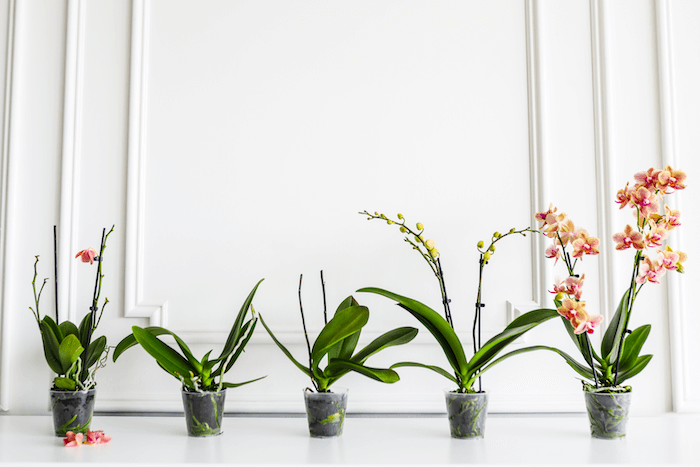
If you've been watching in horror as your orchid slowly loses its petals and leaves, you're not alone. This common yet misunderstood occurrence is why frantic plant parents often call us asking, “Is my orchid dead?”
Fortunately, the answer is usually “no." Your orchid is probably preparing to enter its resting period. Just as trees lose their beautiful leaves in fall and then grow new ones in spring, an orchid’s life cycle includes a resting stage — often in the winter months — during which they lose their flowers and some of their leaves to prepare for blooming in the spring and summer.
Although dormant orchids don’t produce flowers, taking care of your orchid during its resting stage is important for reblooming in the future.
Here are some proactive dormant orchid care tips to encourage regrowth.
You may think that because your orchid isn’t flourishing with vibrant, colorful flowers maintaining your watering schedule is unimportant, but this is far from the truth.
Your plant is alive, well, and just as thirsty! Continue watering as usual with three ice cubes a week for a regular-sized plant, two for petite orchids, and one for mini orchids. Watering gives your plant the fuel it needs for reblooming.
If you notice anything changing with your plant during its resting stage, it is common to assume you should change your care. However, don’t be so quick to do that, your plant may just be adjusting to the change in season, and temperatures or losing its leaves.
Dormant orchids still need nutrients, even in their resting phase. Fertilizing your resting orchid is crucial for reblooming. Unlike other houseplants, orchids don’t receive nutrients from their soil. Instead, they soak up the nutrients from fertilizer and their potting medium. Fertilizer is kind of like a vitamin for plants and powers regrowth. For optimum reblooming, fertilize your orchid every two weeks or once a month with a balanced fertilizer (20-20-20 or 10-10-10) mixed at half-strength. Do not water your orchid during the weeks you fertilize or you will overwater your plant.
During dormancy, make sure to provide your orchid plant with plenty of indirect sunlight. Although your plant craves warmth and light from the sun, too much direct sunlight can kill your orchid plant at any stage of its life cycle. Add sheer curtains to your windows to give your plant the perfect amount of sunshine!
Pro Tip: For maximum regrowth of dormant orchids, place your plant in a room with a temperature between 65-75 degrees Fahrenheit.
This is not extremely straightforward. Typically, orchids will bloom for 8-12 weeks, but that is dependent on when you bring your orchid home from the store. If you brought it home and all buds were open and flowering, you may only get about 8 weeks. If you brought your plant home and several buds were still closed, you may be able to get closer to 12 weeks of blooms from your plant before it drops its blooms and enters its dormant state.
Once your orchid loses all of its blooms, it has entered its dormant state. All that remains are stems and leaves above the soil. You can use this time to trim back your stems and continue your care for your plant, so it can find new growth in 6-9 months.
Remember, you don’t want to neglect your orchid just because it isn’t as pretty as it was in bloom. It still needs the same care in order to see new blooms in the future.
Once your orchid petals have all fallen off, you must remove the flower spike with a sterile knife or scissors to prevent infection. Once you’ve made a clean cut, apply a fungicide directly onto it. If you want to try a natural fungicide, sprinkle cinnamon onto the pruning cut to prevent fungus growth.
Your orchid receives nutrients from its potting medium, so repotting your orchid in a larger plastic pot will help it continue to grow. You should repot your plant every 1-2 years. If your potting medium begins to give a foul odor, repot immediately!
Pro Tip: Phalaenopsis Orchids will naturally lose between one and three leaves a year; usually these will be the oldest leaves at the base of the plant. This process starts with wilting. Next, the leaves are yellow, eventually transforming into dried and easy-to-remove leaves. Be careful not to remove them early as the plant reclaims the nutrients in the leaves as they yellow!
Losing multiple leaves over a short period of time is not normal. This is your cue to check on the health of your orchid's root system!
Waiting for your orchid to rebloom can take months. Not only do blooms fall off during dormancy, but the orchid stem may also dry and turn brown, and the remaining orchid leaves may take on a dull and faded appearance or become limp and flat. This is why people often mistake resting orchids for being dead.
If you take good care of your orchid by following these tips, your plant’s next bloom might just be the best one yet!
Try our repotting kit to make the transition simple and easy.

Copyright Just Add Ice® Orchids 2023